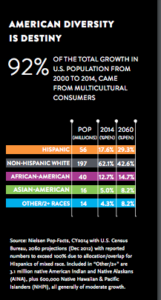I love a genuine, feel-good campaign, especially when the brand’s expression makes me feel connected, represented and understood. It’s not easy to achieve but when you see it executed well, you know right away the campaign’s a home run if it resonates and connects on a deeper level. Some brands have pulled it off – expertly. My favorites? Honey Maid’s “This is Wholesome” campaign and Wells Fargo’s “Learning Sign Language” commercials.
Examples of campaigns gone wrong include Pepsi’s failed attempt to invoke the seriousness and passion of the Black Lives Matter movement. Also, Dove’s inappropriate and offensive portrayal of a black woman turning into a white woman.
The Honey Maid and Wells Fargo campaigns are compelling because of what they represent in the creative. The brands connect on a human level with messages that align with universal values and emotions that consumers hold dear – family, love and equality. They represent a true reflection of our world today and bring to the forefront segments of our population that have not been visible in big brand commercials of the past. Two fathers, two mothers, a child with a disability, a racially blended family are portrayed naturally in everyday settings, and in a positive light. They are not supporting characters in a general market ad, but the leads. Yet, this balanced portrayal of diverse consumers seems
to be the exception and not the norm.
A consumer survey conducted by Marketing Week in partnership with One Poll revealed that “nearly half (42%) of marketers believe the brands they work for are failing to reflect a contemporary, racially-diverse, society in their marketing and advertising” (MarketingWeek.com, 2017). Marketers understand the world is changing and the old notion of the “separate but equal” general market and multicultural marketing approaches are no longer an ideal model for addressing the increasingly diverse marketplace (CampaignLive.com, 2017).
Multicultural consumers are changing the face of the U.S. population and are considered “super consumers” with $3.4 trillion in buying power in 2014 alone. Their buying power is expected to grow exponentially in the decades to come. Understanding and meeting the needs of multicultural consumers will be critical for brands looking to expand their bottom lines. The result has propelled a shift by marketers and brands to a Total Market marketing strategy approach. The Association of Hispanic Advertising Agencies (AHAA) defines Total Market strategy as:
“A marketing approach followed by corporations with their trusted internal and external partners which proactively integrates diverse segment considerations. This is done from inception, through the entire strategic process and execution, with the goal of enhancing value and growth effectiveness. In marketing communications this could lead to either one fully integrated cross-cultural approach, individual segment approaches, or both in many cases, but always aligned under one overarching strategy.”
So, instead of having separate strategies for diverse segments under a multicultural marketing team, there is one broad overarching strategy that maximizes cross-segment insights and universal truths to inform campaigns. The Honey Maid and Wells Fargo commercials are examples of a Total Market campaign designed with the diverse consumer in mind and distributed through segment and general market channels to reach a more diverse general market population.

Multicultural consumers represent the growth engine of the U.S. population with significant buying power today and in the future.
According to an article by Jeffrey L. Bowman, founder of Reframe: The Brand, there needs to be “talent within the organization to fully comprehend and execute the total market approach for the new marketplace and the total market enterprise approach for the new workplace.” This makes so much sense. However, there is one glaring industry challenge. Diverse talent in agencies and business is underrepresented and does not reflect the new mainstream American consumer. A 2017 Bureau of Labor Statistics survey indicates that of nearly 560,000 people employed in advertising, public relations and related industries, only 8.9 percent identified as Hispanic or Latino, 7.4 percent as Asian and 5.8 percent as Black or African American. Clearly, the industry does not represent the changing demographics we see today and in the impending future. If companies plan to tap into consumer needs guided by diverse segment insights, more must be done by agencies and brands to attract, develop and retain diverse talent. There is no other option.
Reflecting on the Pepsi and Dove campaigns, it’s difficult to imagine that companies of this size with budgets and resources to secure the most talented of agencies, released tone-deaf and insensitive advertising campaigns. Certainly, each creative concept underwent multiple layers of approvals and reviews within each company ahead of launch. Was there no one at the creative and decision-making table able to recognize the misstep and flag the campaigns as a reputation risk? If there are diverse professionals with in-depth knowledge of the nuances of these communities at the table, were they not comfortable raising their hand to object? We likely will never know, but I’d venture to say it’s both.
I’ll leave you with a few compelling articles I found when reading up on the Total Market approach and diverse talent in the marketing communications industry. They provide additional perspective on both topics.
Articles:
- “Multicultural Marketing: Have You Considered a ‘Total Market’ Approach?”
- “The Debate Over ‘Total Market’ And Multicultural Marketing”
- “raceAhead: Why is Public Relations so White?”
References
Jeffrey L. Bowman February. Close the gap: The state of the ‘total market’ industry. Retrieved from https://www.campaignlive.com/article/close-gap-state-total-market-industry/1425286
Pepsi’s ad failure shows the importance of diversity and market research. (2017, April 7). Retrieved from https://www.marketingweek.com/2017/04/07/pepsi-scandal-prove-lack-diversity-house-work-flawed/
School, T. W., Pennsylvania, U. o., Street, 3. S., & Hall, 3. V. (2014a, -10-14T20:25:13+00:00). Integrating lead-generation marketing campaigns. Wharton Magazine, Retrieved from http://whartonmagazine.com/blogs/integrating-lead-generation-marketing-campaigns/




3 Responses to A “Total Market” Approach is a Total Miss without Diverse Talent